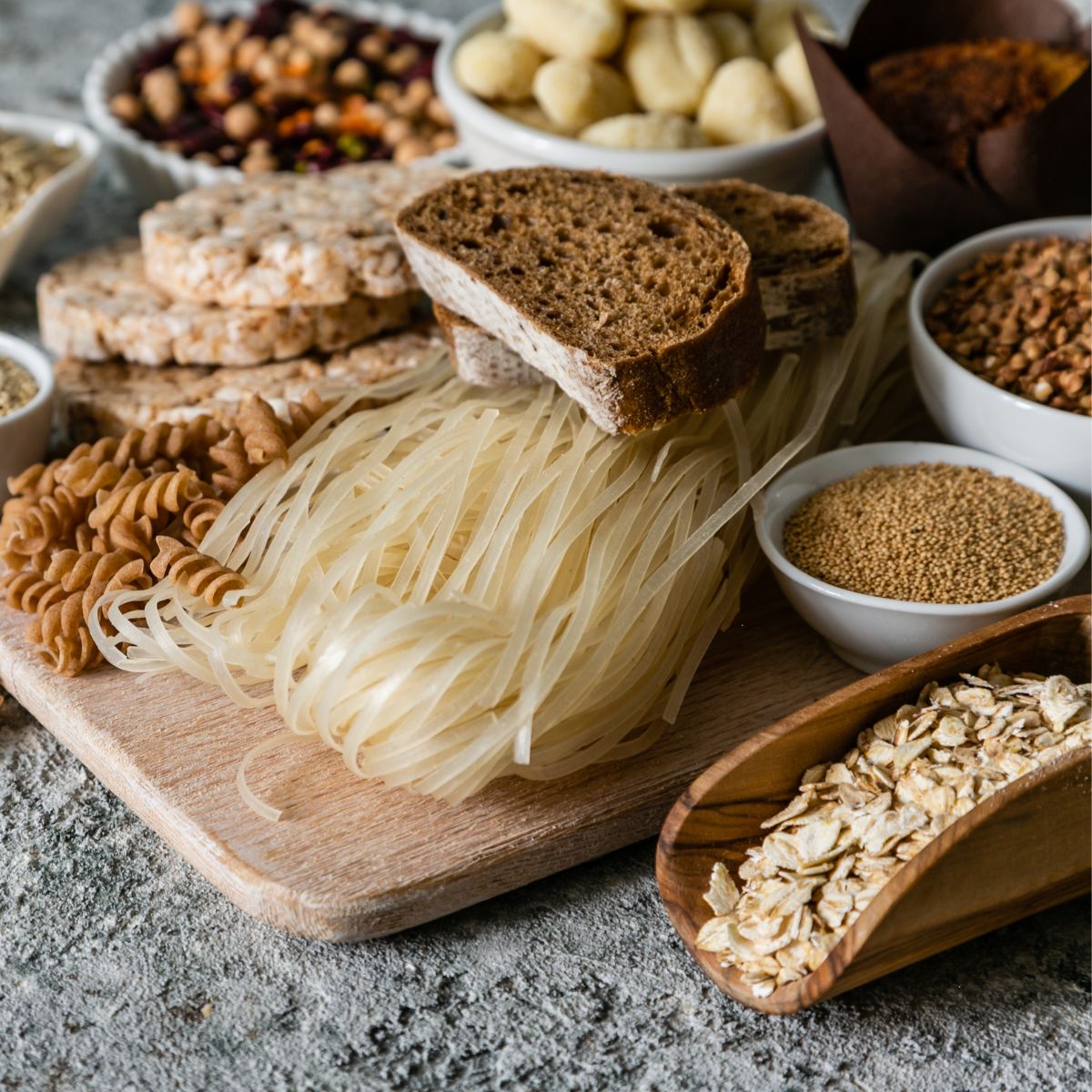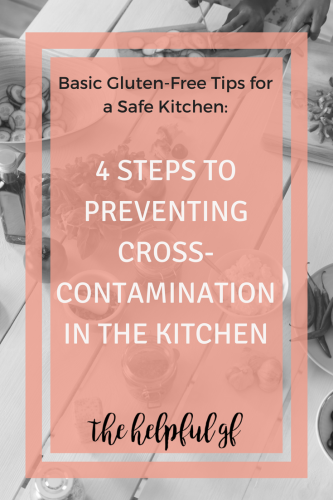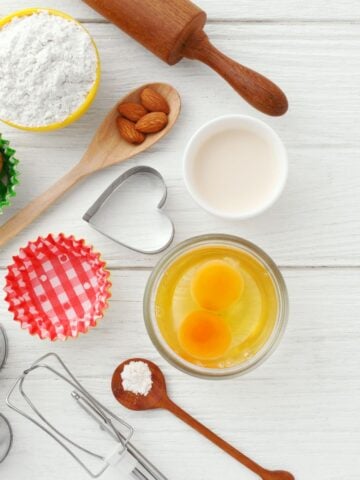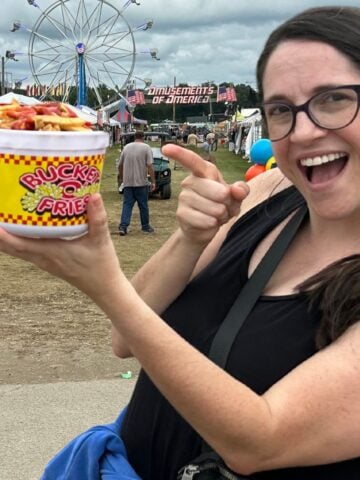Studies have shown that individuals with Celiac disease may have increased anxiety after diagnosis (this is highly correlative to disease management, read more about it here).
For individuals with gluten-free dietary restrictions, the kitchen transforms from being a place of gathering and fellowship to a place of great anxiety.
How can you ensure a safe kitchen for your gluten-free family member or guest to avoid gluten cross contamination?
Let’s start with the basics.
Are you new here? Here's tips to live gluten-free without the stress!
- How to eat out SAFELY when you’re gluten-free
- How to make ANY recipe gluten-free
- How to TRAVEL gluten-free and still have fun
…get valuable support in my EXCLUSIVE Facebook community “Stress-Free Gluten-Free” by clicking here!
The gluten-free guide below is based on personal experience and research. Always be sure to discuss any medical changes with your doctor for your personal medical needs. Additionally, this post contains affiliate links. As an Amazon Associate I earn from qualifying purchases. My full disclosure isn’t that interesting, but you can find it here.
4 Steps to Prevent Gluten Cross Contamination in the Kitchen: Basic Gluten-Free Tips for a Safe Kitchen
Once you have an idea of what foods contain gluten, it's important to understand it's not simply just whether you avoid consuming these foods. It's also important that crumbs and residue of these foods don't end up in your gluten free food. This is called cross contact or cross contamination.
Keep reading to learn how to avoid cross contact/ cross contamination.

1. Educate yourself about gluten cross contact and why it is a big deal.
You can’t protect your loved ones with a kitchen safe from gluten cross contamination if you don’t understand what gluten is.
Gluten is a protein found in wheat, rye, and barley. Individuals diagnosed with Celiac Disease and other gluten-intolerances can become very ill from ingesting gluten.
For Celiacs, even a crumb of glutenous food can cause damage to the small intestine.
It is currently estimated that 1% of the United States population has Celiac, so chances are, you may be faced with cooking for an individual with Celiac in your home! So, keep reading. 🙂
Lean more about my husband, Tyler’s journey with Celiac disease here.
Take this quick quiz and uncover the secrets to making your gluten-free lifestyle not just manageable, but truly enjoyable with custom recipes and tips!

2. Clean, clean, CLEAN!
In most cases, a thorough cleaning will clear away gluten. yay! However, there are some cases in which this isn’t the case. (Continue to point 3 for more information on these exceptions.)
Now, when I say “thorough cleaning” I mean cleaning EVERYTHING. All counters, utensils, pots, plans, dishes, the sink, the table. Everything.
Really? Clean EVERYTHING IN MY KITCHEN?
If you’re only having someone over for one meal, you obviously don’t have to take everything out of your cabinets and clean everything in your kitchen.
But at the minimum, you must be sure you wash everything that will be a part of food preparation & service.
This includes all counter tops, tables, the sink, or anything else that may be touched during preparation. And now that the sponge or rag you used for cleaning probably contains gluten, it’s even a good idea to throw it in the wash after.
While it may not be as good for the environment, I often just use paper towels or these gluten-free cleaning wipes!
If you have someone permanently sharing the kitchen who is gluten-free, it’s probably a good idea to have a “gluten station.”
This means restricting all gluten-containing foods to one area to avoid any wide-spread gluten cross contamination from the beginning.
In our family, our kids eat regular bread and tortillas, as well as cereal and some snacks.
All gluten-filled bread is stored inside a metal bread box (we have this one from Amazon, isn’t it so cute? I love it!).
Gluten-filled cereal is only served in kids’ plastic bowls with kid's plastic spoons; and any special 'kid snacks' containing gluten are stored in a special “snack basket” in the pantry.
Most of the time, these snacks are only packed in their lunches for school or trips. If you’re a toddler parent, you know that toddlers + snacks = crumb disasters.
If the kids eat gluten at home, they are restricted to the kitchen table which allows for easy(ish) clean up to reduce gluten cross contamination!
3. BUY DUPLICATES
Remember how I mentioned that some things probably can’t just be cleaned?
There are several items in which you just need to buy duplicates, use one solely for gluten-free use, and label it clearly.
This applies to kitchen gadgets and food. Here’s a list of common items to have duplicates of (or to avoid using when hosting a gluten-free guest):
Kitchen Gadgets
- Toaster. (Can you say crumbs galore?? Either buy a second toaster and label “gluten-free,” or switch to a toaster oven like we did. With a toaster oven, you can buy a mini cookie sheet to use for gluten-free toasting.)
- Wooden Utensils. (Wood is porous and gluten proteins can easily hide in the cracks)
- Cutting Boards. (Whether it is wooden or not, after frequent use there are often cuts or cracks in the surface of the board which can trap gluten. Color coded sets like this make it easy to keep all gluten on one board!)
- Colanders. (It’s easy for gluten to be trapped in the little drain holes)
- Baking stoneware and cast iron. (Just like wood, these materials are porous. In addition, to truly care for stoneware and cast iron, you should not “wash thoroughly.”)
- Knives. (Knives are pretty simple to clean, but I can’t tell you how many times I’ve watched someone cut gluten-filled bread with a knife and slide it right back into the block without washing it first. This contaminates the block. One tip could be to store knives on a magnetic strip. We have this one.)
- Cooking & Serving Utensils. (While these are easily cleaned—unless they are fraying, then replace!—it’s extremely important to always use separate utensils when preparing both gluten containing and gluten-free food. For example, if you are making two pots of pasta, one regular and one gluten-free, be sure you do not stir them with the same spoon! This will contaminate the whole pot of gluten-free pasta.)
Bonus Tip: Cross Contact on the Grill
Although they aren’t technically “in the kitchen,” grills are another place where contamination is super common due to grilling hamburger buns, brushing gluten-containing BBQ sauce on ribs, and more.
The grill is an appliance that’s difficult to clean thoroughly (gluten proteins can hide in various bumps and cracks) and they’re too expensive for the typical family to have a separate one labeled gluten-free.
Although our family’s personal grill is always gluten-free, we’ve invested in a set of these grill mats.
These are super easy to bring with you to cook outs and it greatly lessens the risk of gluten cross contamination! If you’re extra worried, bring your own set of grill spatula and tongs too!
Read 7 tips about avoiding gluten cross-contamination at a cookout here!
Food
When utensils are dipped in a condiment jar, spread on bread, and dipped back into the jar, the condiments are now contaminated with crumbs.
To ensure a safe kitchen, buy condiments in squeeze bottles. Otherwise, you will need to buy 2 and label the gluten-free one very clearly!
Some of the common foods that we have duplicates (or a squeeze bottle when applicable) of are:
- Butter. (In our home, butter is only used on gluten-free bread. When we go to someone else’s home, butter is cut off a fresh stick and put directly on Tyler's plate.)
- Peanut (and other nut) butters.
- Jelly or Jam. (We usually buy these in squeeze bottles.)
- Mayonnaise and other condiments. (Again, we usually get squeeze bottles if intending to use for both gluten and gluten-free cooking.)
What's they key to loving your gluten free life? Get your personalized plan with the guide you need to thrive!

4. STORE AND SERVE GLUTEN-FREE ITEMS SEPARATELY
Once you have a safe kitchen for prepping and cooking, it’s necessary to keep ingredients, prepared food, and leftovers safe from contamination as well. Always store gluten-free food separate from gluten-containing food (like the bread box mentioned previously).
One easy tip is to keep gluten-free food on higher shelves, and gluten containing food on lower shelves. This way gluten crumbs can’t drop into the gluten-free food.
When serving food (either family or buffet style), serve the gluten-free food first. This helps ensure that gluten crumbs don’t drop into gluten-free food.
Also, please let the gluten-free individual go through first. This helps ensure that there's no accidental gluten cross contamination through the switching of spoons in dishes, or even the serving spoons touching gluten. Think of a taco bar with regular and gluten free tortillas.
Once someone touches the spoon used to serve meat, sour cream, etc. to their flour tortilla and sticks it back in, they’ve now contaminated the food. Cue sad tears for the contamination of your carefully prepared food.
When storing leftovers, be sure tightly wrap gluten-free foods and keep on an upper shelf.
Do you have other tips on how to keep a safe kitchen for individuals with gluten intolerance? Share them in the comments below!







Vox
Wow! I had never thought that there are some kitchen utensils that can’t be properly cleaned to prevent cross contamination....🙁 We had thought that my son’s eating issues were a result of a low tolerance to gluten, but thankfully, they were not. However, it is good to be aware of issues that might affect other friends and family (especially when providing dishes for pot lucks and snacks, so thanks for sharing valuable information.
thehelpfulgf
I'm happy that you found this helpful!
C
Plastic and silicone are porous like the wooden utensils, so I wouldn't use them, unless there were separate (preferably colour coded) sets for gluten free/non gluten free cooking. I one have metal utensils.
Have you thought about having the whole family going gluten free?
thehelpfulgf
Great points! We were a totally gluten-free household (and really pretty much are except for the food our kids eat outside of the house)--we were instructed by GIs and pediatricians to not have our kids go completely gluten-free unless it was discovered they have autoimmune issues. However, due to their heightened risk we keep a really close eye looking for symptoms. Part of my reasoning in creating this post was focusing on how to prevent cross contamination when there's a shared kitchen--for example, when we go eat at my in laws or friends' houses where they obviously don't already have a gluten-free kitchen. How can we help guard against CC? I hope this is helpful in those situations.
Thanks for the feedback 🙂
Nicole
This is a great article for anyone who is trying to prevent or learn more about cross contamination of any allergen. We have several people in our family with a variety of food allergies. Eating at other people's houses is definitely a cause of anxiety for me.
Kristine
These are very helpful suggestions. My mother in law is gluten-free and she some to visit at least twice a year. Each time she gets sick even with our best efforts. These are great and I will incorporate the next time she visits!
thehelpfulgf
I hope these help her to stay healthy! It's so hard to be gluten-free in someone else's kitchen, your mother in law is lucky to have someone like you to research and try your best to make accommodations. Let me know if you ever have any questions <3
DECIO NOVAIS
Greetings, your information is helping my family here in Brazil, here we have a law that obliges the manufacturers of any food to inform if it "contains" or "does not contain gluten" and this helps a lot, thanks
thehelpfulgf
That's great to hear! thanks for sharing that with us.
Toby Beresford
I think this is a really helpful post. Maintaining a mixed kitchen and providing a mixed diet is so tricky. Sometimes I wonder if the whole kitchen needs a redesign with this in mind. Or even having a separate kitchen. Gluten seems to get everywhere!
thehelpfulgf
Yes, it is so tricky! I mean, having a separate kitchen, while not practical for most people, really would be ideal!